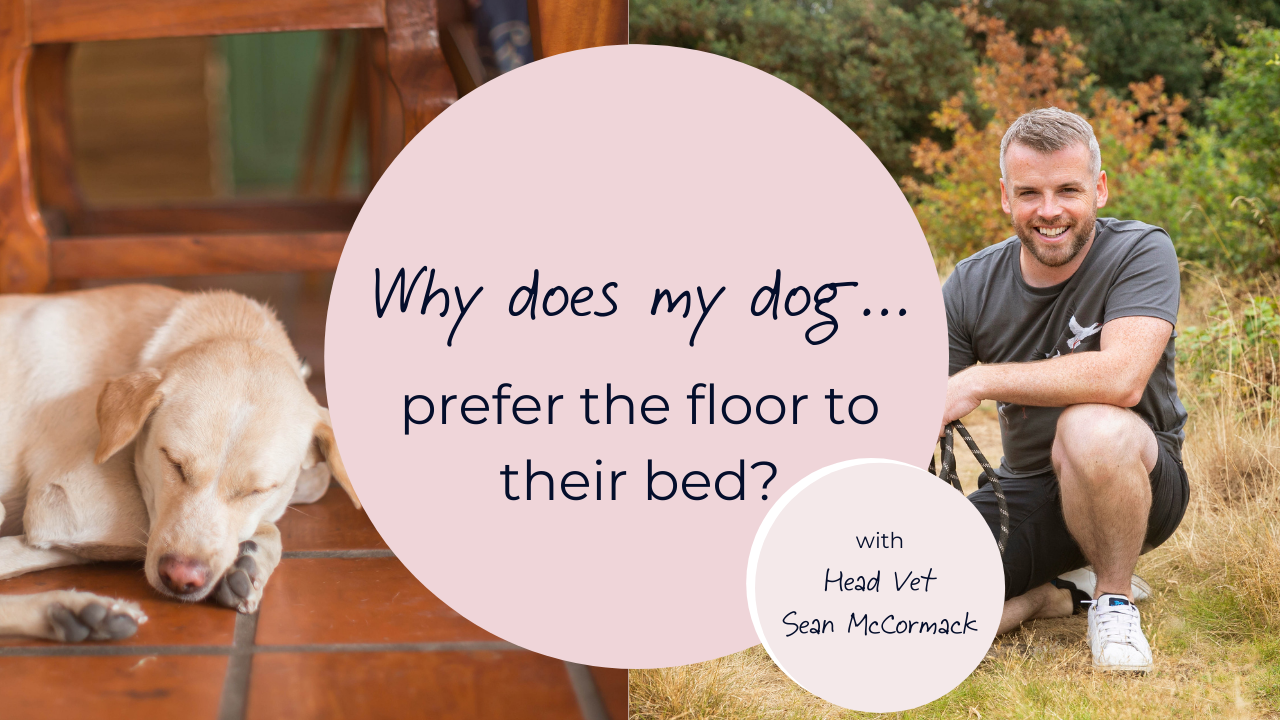The soft, fluffy bed. The one you lovingly chose, hoping to provide your furry best friend with the most comfortable sleeping experience. Yet, there you find them, nestled on the cold, hard floor, snoozing away like a little canine Buddha. It’s a common sight for many dog owners, a puzzle that can spark concern or even a little amusement. Why do dogs, creatures so devoted to comfort and warmth, choose the harsher, colder alternative?

Image: tails.com
It’s a question that has dog owners scratching their heads and seeking answers. This article delves deep into the fascinating reasons behind this seemingly perplexing behavior, exploring everything from instinctual drives to environmental preferences.
Unpacking the Mystery: Understanding the Why Behind Your Dog’s Floor Preference
Perhaps the first thing to understand is that this behavior is often not a cause for alarm. While it might seem strange to us, for our dogs, choosing to sleep on the floor is often a natural, even instinctive, choice. There are several contributing factors to consider:
1. The Primitive Instincts: Our domesticated dogs are descendants of wolves, creatures who thrived in the wild. They would often seek out low-lying spaces, like valleys or caves, for shelter and protection. It’s a primal instinct ingrained within their DNA, and the floor can offer a similar sense of security and grounding. The act of “denning” is deeply rooted in a sense of safety and security, making the floor a comforting choice.
2. The Power of Temperature: Dogs, unlike humans, have a unique ability to regulate their body temperature through their paws. The floor, with its cool surface, can offer a refreshing respite from warm temperatures, particularly during the summer months. This is especially true for breeds with thicker fur, who may find it difficult to cool down on a fluffy bed.
3. The Scent Factor: Dogs, as you probably already know, have an incredible sense of smell. They use scent to navigate their world, communicate with each other, and even to identify their territory. The floor, with its accumulation of familiar scents, can be a comforting and reassuring place for your pup.
4. A Deeper Look at Comfort: While it may seem counterintuitive, the floor can be a source of comfort for certain dogs. For dogs who feel insecure or anxious, the floor provides a sense of stability and groundedness. They may find the bed too high, too soft, or even too exposed, preferring the security of a flat, solid surface.
5. The Influence of the Bed: Sometimes the reason your dog chooses the floor over their bed might be rooted in the bed itself. Perhaps it isn’t soft enough, or perhaps it’s positioned in an area that’s too noisy or too bright, making it feel less appealing.
6. Age and Health: As dogs age, their joints can become stiff and sore. A firm surface like the floor can provide more support and stability compared to a soft bed. Additionally, certain health conditions could also contribute to a preference for the floor.
7. A Call for Exploration: Don’t forget, dogs are playful creatures! They may simply enjoy the unique tactile experience of the floor, or see it as an extension of their play area.
Addressing the Floor Preference: Strategies for a Happy Sleep
While there’s nothing inherently wrong with your dog sleeping on the floor, there are steps you can take to encourage your canine companion to embrace their bed:
1. Get to Know Your Dog: Understanding your dog’s individual needs and preferences is key. Is your dog sensitive to temperature? Do they crave a sense of security? Addressing their specific needs can greatly influence their sleeping habits.
2. The Perfect Bed: Invest in a comfortable, supportive bed designed to meet your dog’s size and build. Consider their age, health, and preferences. A memory foam bed might offer ideal support, while a cooling mat could address heat sensitivity.
3. Location, Location, Location: Consider the positioning of your dog’s bed. Is it in a quiet, draft-free area? Is it away from loud noises and sources of light? A comfortable, secluded spot will make a bed much more enticing.
4. Embrace the Power of Scent: Encourage your dog to associate their bed with their favorite smells. Place a blanket or toy they love on the bed, or sprinkle a few drops of their favorite dog pheromone spray.
5. Make It a Routine: Create a consistent bedtime routine to signal sleep time and help your dog associate the bed with relaxation. This could involve offering a treat on the bed or giving them a gentle massage before they settle down for the night.
6. Patience and Positive Reinforcement: Don’t expect instant results. Patience is key! Encourage your dog to use their bed by rewarding positive behavior with treats, praise, or a favorite toy.
7. Consult Your Veterinarian: If you notice a sudden change in your dog’s sleeping habits, and it is accompanied by other symptoms like lethargy or appetite changes, consult your veterinarian. There could be an underlying health issue that requires professional attention.

Image: www.dognotebook.com
My Dog Sleeps On The Floor Instead Of Her Bed
A Final Word on the Floor-Sleeping Dog
Ultimately, the choice of where your dog sleeps is theirs. It’s a reflection of their individual preferences, comfort levels, and even their instinctual drives. While it might seem perplexing to us, it’s important to respect their choices and understand the reasons behind them. By observing your dog’s behavior, understanding their needs, and providing a comfortable and safe environment, you can create a happy sleeping space for your canine companion.






